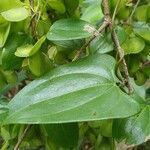A slender, wiry climber. It does not have prickles. The leaves are sword shaped and thin textured. They are 8-10 cm long and 3-4 cm wide. They are dark green above and paler underneath. They have 3 prominent veins. The flowers are small and greenish-white. They occur in loose clusters in the axils of leaves. The fruit are black berries. They are 5-8 mm across. They have 3 seeds.

